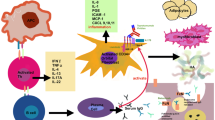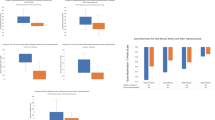Abstract
Background
Rapamycin (alternatively known as sirolimus) is a macrolide immunosuppressant commonly used for organ transplantation. It acts both on lymphocytes through the mechanistic target of rapamycin (mTOR) pathway to reduce their sensitivity to interleukin-2 (IL-2) and, importantly, also has anti-fibrotic properties by acting on myofibroblasts. The latter have been implicated in the pathogenesis of thyroid eye disease (TED).
Aim
To describe successful treatment and reversal of extraocular muscle fibrosis in TED with sirolimus.
Methods
Case report and literature review with clinic-pathological correlation.
Results
A patient with Graves’ orbitopathy (GO) developed significant ocular motility restriction, which was unresponsive to steroids and conventional immunosuppression. Unlike these prior treatments, rapamycin therapy improved the diplopia and fields of binocular single vision over a period of months. There were no adverse effects directly attributable to the treatment.
Conclusion
With its low renal toxicity and ability to specifically target the underlying fibrotic pathways in GO, rapamycin may prove a useful adjunct to standard immunosuppressive regimes. We encourage further reporting of case series or the instigation of controlled trial.
Similar content being viewed by others
Login or create a free account to read this content
Gain free access to this article, as well as selected content from this journal and more on nature.com
or
References
Zhang L, Grennan-Jones F, Lane C, Rees DA, Dayan CM, Ludgate M. Adipose tissue depot-specific differences in the regulation of hyaluronan production of relevance to Graves’ orbitopathy. J Clin Endocrinol Metab. 2012;97:653–62.
Molina-Molina M, Machahua-Huamani C, Vicens-Zygmunt V, Llatjós R, Escobar I, Sala-Llinas E, et al. Anti-fibrotic effects of pirfenidone and rapamycin in primary IPF fibroblasts and human alveolar epithelial cells. BMC Pulm Med. 2018;18:63.
Pritchard J, Horst N, Cruikshank W, Smith TJ. Igs from patients with Graves’ disease induce the expression of T cell chemoattractants in their fibroblasts. J Immunol. 2002;168:942–50.
Hillel AT, Gelbard A. Unleashing rapamycin in fibrosis. Oncotarget. 2015;6:15722–3.
Ghosh A, Malaisrie N, Leahy KP, Singhal S, Einhorn E, Howlett P, et al. Cellular adaptive inflammation mediates airway granulation in a murine model of subglottic stenosis. Otolaryngol Head Neck Surg. 2011;144:927–33.
Chen G, Chen H, Wang C, Peng Y, Sun L, Liu H, et al. Rapamycin ameliorates kidney fibrosis by inhibiting the activation of mTOR signaling in interstitial macrophages and myofibroblasts. PLoS ONE. 2012;7:e33626.
Yu SY, Liu L, Li P, Li J. Rapamycin inhibits the mTOR/p70S6K pathway and attenuates cardiac fibrosis in adriamycin-induced dilated cardiomyopathy. Thorac Cardiovasc Surg. 2013;61:223–8.
Krassas GE, Gogakos A. Thyroid-associated ophthalmopathy in juvenile Graves’ disease—clinical, endocrine and therapeutic aspects. J Pediatr Endocrinol Metab. 2006;19:1193–206.
Smith TJ, Kahaly GJ, Ezra DG, Fleming JC, Dailey RA, Tang RA, et al. Teprotumumab for thyroid-associated ophthalmopathy. N Engl J Med. 2017;376:1748–61.
Chang S, Perry JD, Kosmorsky GS, Braun WE. Rapamycin for treatment of refractory dysthyroid compressive optic neuropathy. Ophthalmic Plast Reconstr Surg. 2007;23:225–6.
Roos JCP, Murthy R. Comment on: A British Ophthalmic Surveillance Unit (BOSU) study into dysthyroid optic neuropathy in the United Kingdom. Eye (Lond). 2018; https://doi.org/10.1038/s41433-018-0303-0.
Nashan B, Citterio F. Wound healing complications and the use of mammalian target of rapamycin inhibitors in kidney transplantation: a critical review of the literature. Transplantation. 2012;94:547–61.
Fitzsimons R, White J. Functional scoring of the field of binocular single vision. Ophthalmology. 1990;97:33–5.
Zhang L, Ji QH, Ruge F, Lane C, Morris D, Tee AR, et al. Reversal of pathological features of graves’ orbitopathy by activation of forkhead transcription factors, FOXOs. J Clin Endocrinol Metab. 2016;101:114–22.
Das T, Roos JCP, Patterson AJ, Graves MJ, Murthy R. T2-relaxation mapping and fat fraction assessment to objectively quantify clinical activity in thyroid eye disease: an initial feasibility study. Eye (Lond). 2018; https://doi.org/10.1038/s41433-018-0304-z.
Roos JCP, Paulpandian V, Murthy R. Serial TSH-receptor antibody levels to guide the management of thyroid eye disease: the impact of smoking, immunosuppression, radio-iodine, and thyroidectomy. Eye (Lond). 2018; https://doi.org/10.1038/s41433-018-0242-9.
Mourits MP, Koornneef L, Wiersinga WM, Prummel MF, Berghout A, van der Gaag R. Clinical criteria for the assessment of disease activity in Graves’ ophthalmopathy: a novel approach. Br J Ophthalmol. 1989;73:639–44.
Acknowledgements
The authors would like to thank Dr. Paul Meyer.
Author contributions
All authors have contributed to the data collection and writing.
Author information
Authors and Affiliations
Corresponding author
Ethics declarations
Conflict of interest
All authors are doctors who manage patients with thyroid eye disease. The authors declare that they have no conflict of interest.
Ethics statement
As an anonymised retrospective report no institutional review board authorisation was necessary.
Guarantor
Dr. Murthy serves as guarantor of this work. It is an honest, accurate and transparent account of the study being reported; no important aspects of the study have been omitted.
Additional information
Publisher’s note: Springer Nature remains neutral with regard to jurisdictional claims in published maps and institutional affiliations.
License: The corresponding author has the right to grant on behalf of all authors and does grant on behalf of all authors, an exclusive licence on a worldwide basis to permit this article to be published.
Rights and permissions
About this article
Cite this article
Roos, J.C.P., Murthy, R. Sirolimus (rapamycin) for the targeted treatment of the fibrotic sequelae of Graves’ orbitopathy. Eye 33, 679–682 (2019). https://doi.org/10.1038/s41433-019-0340-3
Received:
Accepted:
Published:
Issue Date:
DOI: https://doi.org/10.1038/s41433-019-0340-3
This article is cited by
-
The changing landscape of thyroid eye disease: current clinical advances and future outlook
Eye (2024)
-
Long-term outcome of Graves’ orbitopathy following treatment with sirolimus
Journal of Endocrinological Investigation (2024)
-
Impact of novel microbial secondary metabolites on the pharma industry
Applied Microbiology and Biotechnology (2022)
-
Sirolimus as a second-line treatment for Graves’ orbitopathy
Journal of Endocrinological Investigation (2022)



